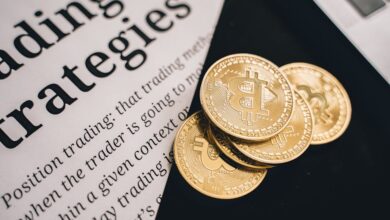Unlocking the Gold Market: A Comprehensive Guide to Gold ETFs and Their Role in Safe Haven Investments

**Unlocking the Power of Gold: Your Guide to Gold ETFs and Physical Gold Investment**
As investors seek stability amid economic uncertainty, gold has long been regarded as a safe haven asset. With the rise of gold ETFs (exchange-traded funds), accessing the gold market has never been easier or more efficient. These investment vehicles allow individuals to invest in gold without the need to physically hold gold bullion, bars, or coins, providing an attractive alternative for those looking to diversify their portfolios. In this article, we will delve into the intricacies of gold ETFs, exploring their role as a gateway to gold investment and physical gold exposure. We’ll also analyze how gold market trends influence the performance of these funds, particularly in response to inflation and global demand shifts. Finally, we will discuss the importance of gold ETFs in enhancing your investment strategy, linking them to gold mining, recycling, and the evolving landscape of gold production. Whether you’re a seasoned investor or a newcomer to the gold market, understanding gold ETFs can pave the way for informed decisions in a dynamic financial landscape. Join us as we uncover the potential of gold investment in today’s changing economy.
- 1. "Understanding Gold ETFs: Your Gateway to Gold Investment and Physical Gold Exposure"
- 2. "Navigating Gold Market Trends: How Gold ETFs Respond to Inflation and Global Demand"
1. "Understanding Gold ETFs: Your Gateway to Gold Investment and Physical Gold Exposure"
Investing in gold has long been regarded as a reliable strategy for wealth preservation, particularly in times of economic uncertainty. Gold ETFs (Exchange-Traded Funds) have emerged as a popular gateway for investors seeking exposure to physical gold without the complexities of storing and securing the metal itself. These funds are designed to track the price of gold, giving investors an opportunity to benefit from the fluctuations in gold prices while maintaining liquidity similar to that of stocks.
Gold ETFs are typically backed by physical gold, which means that for every share you purchase, there is a corresponding amount of physical gold held in reserve. This structure provides a tangible asset that reflects the performance of the gold market. As central banks continue to accumulate gold reserves and investors flock to this safe haven asset, the demand for gold-backed products is on the rise. In fact, according to recent market analysis, global gold demand has seen a significant uptick, driven by factors such as inflation and geopolitical tensions.
For those interested in diversifying their portfolios, gold ETFs present a compelling option. They allow for easy access to the gold market, eliminating the hassles associated with gold mining, storage, and security. Unlike gold coins and bullion, which require physical handling and storage, investing in gold ETFs simplifies the process by consolidating ownership into a single tradable asset.
Moreover, gold ETFs can be an excellent hedge against inflation. As the value of currency fluctuates, the intrinsic value of gold tends to rise, making it a strategic investment choice during economic downturns. With gold prices often inversely correlated to the stock market, these ETFs can also provide a degree of portfolio protection during market volatility.
Investors should also consider the sustainability aspect of gold investment. With a growing emphasis on sustainable gold mining practices, many gold ETFs now focus on sourcing gold responsibly, aligning with the increasing demand for ethical investing. This consideration extends beyond just the environmental impact; it also encompasses the social implications of gold mining and trade, such as the prevention of gold smuggling and promoting fair labor practices.
In conclusion, gold ETFs serve as an accessible and efficient way for investors to gain exposure to physical gold, capitalizing on current gold market trends while navigating the complexities of traditional gold investment. Whether you’re looking at gold coins investing, gold jewelry, or luxury gold, the versatility of gold ETFs places them at the forefront of modern investment strategies. By integrating this asset class into your portfolio, you can not only safeguard your wealth but also participate in the dynamic world of gold trade.
—
*Placeholder for image/video*: (Image: Graph showing gold price trends over the last decade – Source: Financial Times).
Gold ETFs, or exchange-traded funds, represent a modern approach to gold investment by allowing investors to gain exposure to physical gold without the need to store or manage the asset directly. These funds are backed by physical gold, typically held in secure vaults, making them a popular choice among those looking to invest in gold without the complexities of buying and storing gold bullion or coins.
The appeal of gold ETFs can be attributed to their liquidity and ease of trading on major stock exchanges, which mirrors the dynamics of the gold market. Investors often turn to gold as a safe haven asset during times of economic instability or inflation, as it historically retains value when other investments falter. As central banks around the world continue to hold substantial gold reserves, the demand for gold remains strong, influencing gold prices and market trends.
Additionally, gold ETFs provide a diversified approach to gold investment, allowing exposure not only to physical gold but also to the underlying factors impacting the gold market, such as gold mining, production, and recycling. For instance, sustainable gold mining practices are increasingly important to investors who are mindful of ethical sourcing and environmental impacts. This trend aligns with the growing global demand for responsible investment options, including luxury gold products, which often come from sustainably sourced materials.
Investors are also eyeing the relationship between gold and cryptocurrency, as both assets have shown resilience in volatile market conditions. While gold continues to be viewed as a stable store of value, cryptocurrencies offer a more speculative investment opportunity. This juxtaposition drives interest in gold futures and the broader gold trade, particularly among those looking to hedge against inflation or currency fluctuations.
In summary, gold ETFs offer a compelling option for both seasoned investors and newcomers interested in gold coins investing, collectibles, or the broader gold market analysis. By understanding the dynamics of gold prices, production, and the global gold demand, investors can make informed decisions that align with their financial strategies and risk tolerance.
2. "Navigating Gold Market Trends: How Gold ETFs Respond to Inflation and Global Demand"
Gold ETFs: Trading exchange-traded funds backed by physical gold
Navigating Gold Market Trends: How Gold ETFs Respond to Inflation and Global Demand
Gold ETFs have increasingly become a popular choice for investors looking to capitalize on the fluctuations in gold prices and market trends. As a safe haven asset, gold has historically provided a hedge against inflation and economic uncertainty. This section explores how gold ETFs react to these factors, particularly focusing on inflationary pressures and the growing global demand for gold.
When inflation rises, the purchasing power of currency diminishes, prompting investors to seek refuge in tangible assets like gold. This shift often leads to increased demand for gold ETFs, which are backed by physical gold reserves. As central banks continue to accumulate gold, adding to their gold reserves, the value of gold tends to rise, thereby influencing gold ETF prices. In recent years, we have witnessed a notable uptick in gold production, linked to both mining and recycling efforts, which enhances the supply chain for these investments.
Additionally, global demand for gold is driven by various sectors, including jewelry, technology, and investment. Luxury gold items, such as gold jewelry and collectibles, represent a significant portion of this demand, particularly in emerging markets where economic growth fuels consumption. Moreover, the gold trade remains robust as gold coins and bullion are sought after by investors looking to diversify their portfolios.
As the gold market evolves, the interplay between gold and cryptocurrency has garnered attention. While cryptocurrencies offer an alternative investment avenue, many still view gold as a more stable option during periods of economic instability. This perception reinforces gold's status as a reliable investment, prompting more investors to turn to gold ETFs for exposure to gold without the complexities of owning physical gold directly.
In terms of market analysis, tracking gold futures can provide insights into future price movements. Investors often analyze trends related to gold mining output and refining processes to gauge the overall health of the gold market. Sustainable gold mining practices are also becoming more relevant, as environmentally conscious investors look for ethical investment opportunities.
In summary, gold ETFs serve as a vital instrument in navigating gold market trends, especially in the context of inflation and global demand. As factors like central bank policies, gold recycling, and international trade continue to shape the landscape, investors can leverage these insights to make informed decisions about their gold investments.
—
**References**
– World Gold Council. (2023). Gold Demand Trends Q2 2023. Retrieved from [www.gold.org](https://www.gold.org)
– Bloomberg. (2023). The Role of Gold in Inflationary Times. Retrieved from [www.bloomberg.com](https://www.bloomberg.com)
– International Monetary Fund. (2023). The Impact of Central Banks on Gold Prices. Retrieved from [www.imf.org](https://www.imf.org)
– Statista. (2023). Global Gold Production by Country 2023. Retrieved from [www.statista.com](https://www.statista.com)
– Financial Times. (2023). Gold ETFs: A Safe Haven for Investors. Retrieved from [www.ft.com](https://www.ft.com)
In conclusion, Gold ETFs represent a compelling option for those looking to invest in gold without the complexities of physical ownership. By providing exposure to gold bullion and its price movements, these exchange-traded funds serve as a bridge to the gold market, allowing investors to navigate fluctuations driven by inflation and global demand. As central banks continue to stockpile gold reserves and the market shows resilience amid economic uncertainties, understanding Gold ETFs will be pivotal for anyone looking to diversify their portfolio with this safe haven asset.
With the ongoing trends in gold prices, the rise of sustainable gold mining practices, and the innovative approaches to gold technology and recycling, the landscape of gold investment is evolving. Investors can also explore the interplay between gold and cryptocurrency, along with the emerging opportunities in luxury gold, gold collectibles, and gold coins investing.
Ultimately, whether you’re interested in gold futures or simply wish to ride the wave of gold market trends, Gold ETFs provide a strategic avenue for both novice and seasoned investors to gain exposure to the timeless allure of gold. By tapping into the potential of these funds, you can position yourself advantageously in a market that has stood the test of time.
Start your journey in the gold trade today, and consider Gold ETFs as a valuable addition to your investment strategy to secure a brighter financial future.





